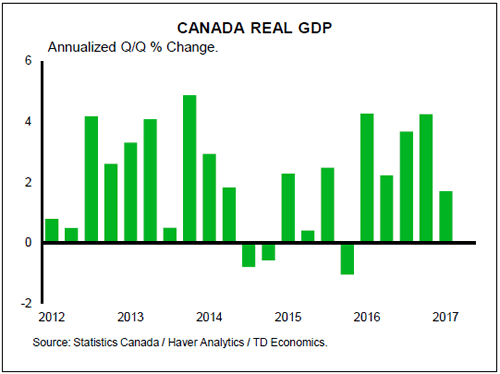U.S. Highlights
- A holiday-shortened trading week light in economic data left markets to focus on communications from the Federal Reserve.
- U.S. existing home sales slumped in January, beleaguered by low inventories and deteriorating affordability.
- The FOMC minutes revealed a Fed busy revising up economic projections, suggesting that further gradual policy firming is warranted.
Canadian Highlights
- The December 2017 data continued to disappoint, with declines in retail and wholesale trade joining earlier softness in trade and manufacturing.
- Real GDP in 2017 as a whole likely saw a robust 2.9% expansion, with a respectable 2.0% pace of growth expected for Q4. The December softness and weaker housing market activity in January suggest a further deceleration is likely, leaving 2018 to start-off on a softer note.
- Noise can mask the trend, which can hardly be defined by a few months’ data. Prudence in the face of domestic and external risks suggests that the Bank of Canada is likely to stand pat until mid-year, when it is better able to assess the underlying Canadian growth trend.
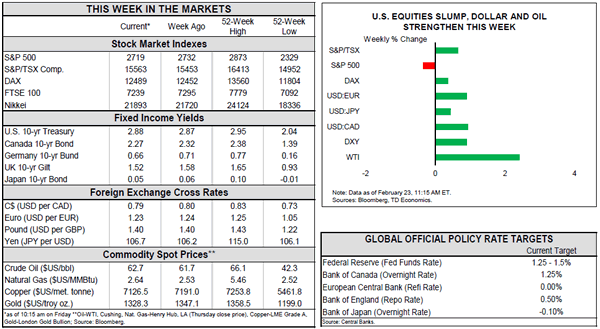
U.S. – More Rate Hikes Incoming
A holiday-shortened trading week coupled with light data left markets with just the minutes from the January FOMC meeting and the words of wisdom from a slew of Federal Reserve speakers this week to digest.
Existing home sales for January revealed a market that is still beleaguered by low inventory, which exacerbates deteriorating housing affordability in many U.S. cities. January’s decline in existing home sales was broad-based, and concentrated in the larger single-family segment (Chart 1). Unsurprisingly, rising prices and borrowing costs are deterring first-time buyers from buying, as they accounted for only 29% of sales in January, down from 33% a year ago. Looking ahead, job gains and an optimistic outlook for after-tax earnings growth should support a rebound in home sales. What’s more, housing starts ticked up in January, possibly providing some respite for buyers particularly in those markets with a low supply of existing homes.
Fed speakers this week remained broadly optimistic about the outlook for the economy, while also revealing very little news about the number of rate hikes this year. In the December Summary of Economic Projections (SEP), the FOMC communicated that it would likely raise rates three times. Since then, the U.S. Congress approved of a massive tax reform package, and just a few weeks ago an additional package of spending that is expected to provide a substantial lift to U.S. growth (Chart 2; read our report on U.S. fiscal stimulus).
The firmer U.S. growth outlook has raised questions about how tolerant a Powell-led Fed would be of above-target inflation. Perhaps one of the most surprising admissions this week was from FRB Philadelphia President Harker, who is not a voting member of the FOMC but a contributor to the quarterly economic projections. He mentioned in a speech on Wednesday that he was comfortable penciling in just two rate hikes for this year, but may adjust if the evolution of the data requires it. This is somewhat counter to what most economic models would suggest, and even an often pessimistic market has moved to price-in about three rate hikes for 2018. Some economic forecasters have penciled in four rate hikes for 2018 after fiscal stimulus was announced.
Nonetheless, the FOMC minutes from its January meeting revealed a Fed busy revising up economic projections for the U.S. economy, and therefore confident that further gradual policy firming is warranted. While there is a lot of room for interpretation on what "further" implies, it’s safe to conclude that rates will rise this year. To be clear, we have stuck with our view from this past December that the economic outlook and balance of risks are consistent with three rate hikes by the Fed this year. However, the additional stimulus from the recently announced fiscal program pushes up our rate hikes for 2019 to three from two. This places the fed funds rate at 3.0% at the end of 2019, and about 20 basis points above the FOMC’s longer-run expectation.


Canada – Clouds on the Horizon?
This week delivered the last few ‘puzzle pieces’ ahead of next week’s GDP report for the final quarter of 2017. Capturing most of the attention was the fairly weak retail sales report, which saw both the dollar value and volume of transactions decline in December (Chart 1). Retail sales joined a generally middling slate of December data: wholesale trade, also reported this week, was down slightly, joining soft trade figures and a mediocre manufacturing report (both released earlier in the month).
In many cases, notably manufacturing and retail sales, December’s weakness comes after stronger performances earlier in the quarter, and in the case of the latter, it is possible that shifts in holiday spending habits (towards Black Friday/Cyber Monday) may not be fully reflected in the seasonally adjusted data. It also bookended a great year overall – 2017 was the best year for retail sales growth since 1997.
All this is to say that fourth quarter growth is likely to come in at a respectable pace of about 2% (q/q annualized) that, while disappointing our early expectations, is still above Canada’s underlying trend. Indeed, growth for 2017 as a whole is likely to mark a 2.9% pace of expansion, its best performance since 2014. This robust performance can be seen in the Bank of Canada’s measures of underlying price pressures (Chart 2). Core inflation has both trended higher in the back half of last year, and the range of measures have tightened up, suggesting that the Bank of Canada’s three rate hikes were likely necessary for the achievement of their 2% inflation target.
Of particular note in the inflation data was the seeming impact of minimum-wage hikes. While they may not have had a significant impact on the aggregate wage data (yet), these hikes made themselves felt in key categories that tend to be associated with minimum wage employment, such as food purchased from restaurants and child care/housekeeping.
Looking ahead, the robust growth of 2017 is likely to fade into the rear-view mirror. December’s soft showing may not have a major impact on Q4, but suggests a softer start to 2018. To be clear, one month hardly makes a trend, but the softened momentum in the December data comes alongside a significant weakening of housing activity in January (See commentary). As expressed in a recent report, the regulatory changes behind January’s weakness are not likely to drive Canadian home markets into a tailspin, but near-term softness is likely to make itself felt in the economy more broadly.
What does all of this mean for the Bank of Canada? At the risk of sounding like a broken record, likely not too much. Near-term growth appears likely to disappoint their expectations, but a continued rising pace of inflation, particularly in their core measures, will provide re-assurance that economic slack has been absorbed and historically low interest rates are no longer required. With risks abounding, both domestic and external, a near-term ‘wait and see’ approach seems most likely. By mid-year, Governor Poloz and company should have a clearer sense of the trend lying beneath recent near-term noise, and feel comfortable that the Canadian economy can withstand another policy interest rate increase.
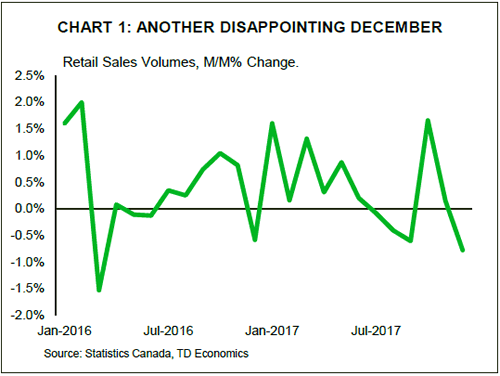
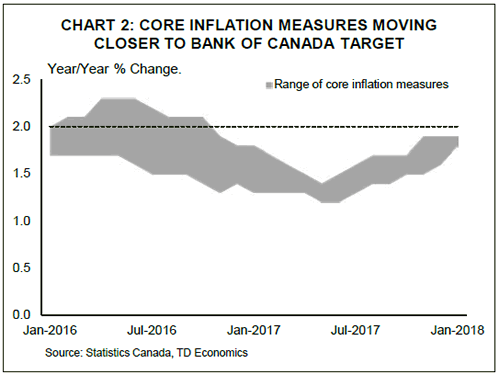
U.S.: Upcoming Key Economic Releases
U.S. Personal Income & Spending – January
Release Date: March 1, 2018
Previous Result: Income 0.4% m/m, Spending 0.4% m/m
TD Forecast: Income 0.2% m/m, Spending 0.2% m/m
Consensus: Income 0.3% m/m, Spending 0.2% m/m
Headline PCE inflation is expected to slip back to 1.6% y/y in January, reflecting a 0.3% m/m rise in prices. The rise reflects higher gasoline prices along with a solid firming in the core. However, we expect core PCE to undershoot the strength recorded in the core CPI and register a 0.2% m/m increase (vs 0.3% m/m in the CPI). This is largely due to the healthcare services component, which we expect to post a more modest uptick than in the CPI report. PCE healthcare prices more closely follow producer level prices, and while the latter rose on balance, the increase was concentrated mainly in hospital outpatient care services. As a result we expect core PCE inflation to be stable at 1.5% y/y.
Nominal PCE (personal spending) is expected to rise 0.2% in January, implying a 0.1% decline in real spending. The weak footing in Q1 would be consistent with real PCE tracking near a relatively modest 2.0%. We expect January spending gains to be driven by services, with a neutral contribution from nondurables and a decline in durable goods spending. We also expect a soft 0.2% increase in December personal income.
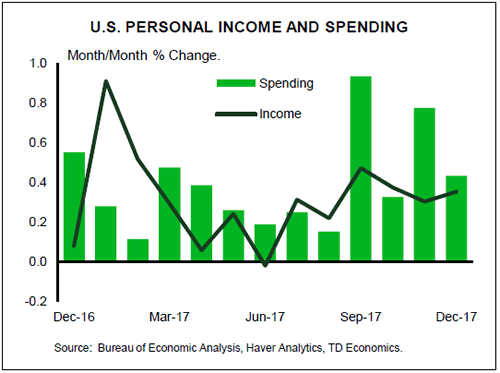
Canada: Upcoming Key Economic Releases
Canadian Real GDP – Q4 & December
Release Date: March 2, 2018
Result: 1.7% q/q ann, 0.4% m/m
TD Forecast: 2.0% q/q ann, 0.1% m/m
Consensus: 2.1% q/q ann, 0.1% m/m
The robust start to 2017 is expected to have given way to a more sustainable close, with fourth quarter GDP growth of 2.0% (q/q, annualized) expected. Net trade is likely to again subtract from growth due to a November surge in goods imports that far outpaced more meagre export gains. Consumer spending should remain healthy, supported by solid aggregate income gains and decent retail sales volumes early in the quarter. Important but difficult-to-pin-down spending on services is expected to have decelerated somewhat from Q3’s 5.3% pace, to 3.6%. Total private investment is expected to remain solid at 2.5%, helped by an expected continuation of business investment (albeit at a relatively more modest 2.7% pace), as well as a pulling-forward of residential activity ahead of January’s B-20 underwriting guideline changes.
Industry-level growth is forecast to rise 0.1% in December. Following a number of downbeat data releases, we expect utilities and a short-term boost from real estate to drive growth. Details should reveal a mixed performance in both goods and services, with the former helped by increased utilities output while a pullback in housing starts and softer manufacturing sales will exert a drag on growth. For services, weaker wholesale and retail sales will weigh on the sector as a whole but we expect a larger contribution from real estate as homebuyers try to circumvent new mortgage rules, though this will unwind next month. In addition to the slowdown in housing, the poor handoff from December will create a more challenging growth environment in Q1.
